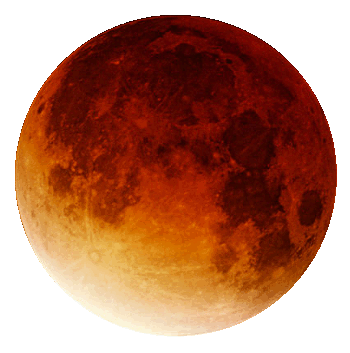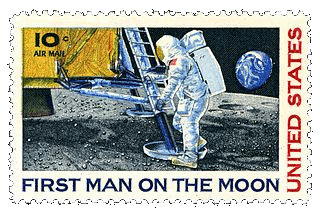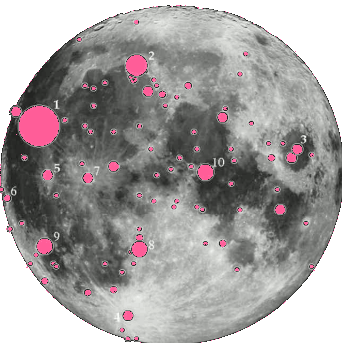Lunar Water
June 4, 2012
Music changed abruptly in my
teen years.
Radio play in the early 1960s was mostly
ballads,
show tunes; and quite a few
novelty records, such as "
Itsy Bitsy Teeny Weeny Yellow Polka Dot Bikini."[1] Then came the
British Invasion, and
America's response.
I was a
Top-40 DJ at a small 1,000
watt AM radio station at the end of the British Invasion. This is a somewhat lesser pedigree than that of
Ted Baxter of
The Mary Tyler Moore Show, who worked at a "five thousand watt radio station in
Fresno, California."
The song,
Moon River (music by
Henry Mancini, lyrics by
Johnny Mercer) was introduced in the 1961
film,
Breakfast at Tiffany's.[2-3] It won the
1961 Academy Award for Best Original Song, the
1962 Grammy Award for Record of the Year, and it's best known as the theme song for
Andy Williams.
There are
so many places on Earth named "Moon" that we never take a phrase like "moon river"
literally. Finding a river on the
Moon is more unlikely than finding one on
Mars, so the
Selenites must be using
water wells. There's the possibility, however, that there was water in the primordial Moon, and some water may still exist there, as
ice, or trapped in
minerals.

With the orange cast, it may look like Mars, but this is a photograph of the Moon during the November 9, 2003, lunar eclipse.
(Photo by Oliver Stein, via Wikimedia Commons))
I wrote about the search for water on the Moon in a
previous article (New Moon, October 25, 2010).
Lunar water would make exploration and habitation of the Moon a lot easier, since
humans require a lot of water to survive. Free water is absent from the Moon's surface, since the Moon's
gravity is too small to retain any
gases, and any liquid water would have
evaporated into space.
As pointed out in two early papers by
Kenneth Watson,
Bruce C. Murray, and
Harrison Brown of
Caltech, the rate of gravitational escape of water
molecules is small enough that water vapor could collect as ice in areas of polar
craters that are perpetually shadowed from the
Sun.[4-5] Their numerical calculations, in the age before rapid computation, showed that the amount of water lost from the Moon in its present condition would have been just a few
grams per square
centimeter of surface area.[5]
In 2010,
NASA tested this hypothesis by a controlled 5,500 mile/hour impact of the
Lunar Crater Observation and Sensing Satellite (LCROSS), and its associated
Centaur rocket, into the
Cabeus crater on the Moon.[6-8] Cabeus is in the Moon's southern polar region, and its walls have protected some portions of the lunar terrain from sunlight for billions of years. The temperature in these regions is about 40
K.
The impact ejected a plume of lunar material nearly ten miles high, and instruments on LCROSS and the
Lunar Reconnaissance Orbiter (LRO) detected
water ice. The data indicate that Cabeus may contain a billion gallons of water, but this amounts to just twice the water density of the
Sahara desert. The plume itself contained about 41
gallons of water, mixed with quite a few
chemicals.[8]

Appropriately, an air mail stamp.
I'm sure Neil Armstrong's boots weren't a protection from getting his feet wet.
(Via Wikimedia Commons))
Arlin Crotts of
Columbia University's department of
Astronomy and Astrophysics has just published three articles on the
arXiv preprint server that review the historical record of observations relating to the existence of water on the Moon.[9-11] These articles collect the available information on lunar water into one convenient record.
Crotts writes that
Harold Urey,
Nobel Laureate in chemistry for his discovery of
deuterium, was a proponent of lunar water.[9] Urey's idea that water can exist on the Moon was not well accepted, and he even wrote that some of his opponents thought that his idea was the product of too much
vodka.[12]
The Moon's
regolith (the loose surface layer), is somewhat impervious to water. A water molecule traveling from just below this layer would have a trillion collisions with particles before reaching the surface. If such molecules have even a small
residence time on the surface of particles, this will add up to times on a
geological scale.[10] Water deep within the Moon would explain deep
quakes, which are facilitated by water on Earth.[10]
Crotts writes about the interesting events called "
transient lunar phenomena," or TLPs, which are the transient changes in the Moon's appearance. Some, of course, are due to
asteroid impacts, but others may arise from gas release. The figure below shows the large extent of these TLPs.

Locations of transient lunar phenomena (TLPs).
The size of the circles represents the number of reports. (1) 46.7% Aristarchus/Schroter's Valley (2) 15.6% Plato.
Moon image is NASA Galileo PIA00405.
(Modified image, via arXiv Preprint Server).[11)]
References:
- Billboard Top 100 Songs of 1960, bobborst.com.
- Breakfast at Tiffany's (1961, Blake Edwards, Director) in the Internet Movie Database.
- A montage of Moon River music from Breakfast at Tiffany's, YouTube video.
- K. Watson, B. C. Murray and H. Brown, "The Behavior of Volatiles on the Lunar Surface," J. Geophys. Res., vol. 66, no. 9 (1961), pp. 3033-3045.
- K. Watson, B. C. Murray and H. Brown, "On the Possible Presence of Ice on the Moon," J. Geophys. Res., vol. 66, no 5 (1961), pp. 1598-1600.
- Michael Braukus, "LCROSS Results Released," NASA Press Release 10-271, October 21, 2010.
- Amina Khan, "Moon is wetter, chemically more complex than thought, NASA says," Los Angeles Times, October 22, 2010.
- Anthony Colaprete, Peter Schultz, Jennifer Heldmann, Diane Wooden, Mark Shirley, Kimberly Ennico, Brendan Hermalyn, William Marshall, Antonio Ricco, Richard C. Elphic, David Goldstein, Dustin Summy, Gwendolyn D. Bart, Erik Asphaug, Don Korycansky, David Landis and Luke Sollitt, "Detection of Water in the LCROSS Ejecta Plume," Science, vol. 330, no. 6003 (October 22, 2010), pp. 463-468.
- Arlin Crotts, "Water on The Moon, I. Historical Overview," arXiv Preprint Server, May 25, 2012
- Arlin Crotts, "Water on The Moon, II. Origins & Resources," arXiv Preprint Server, May 25, 2012
- Arlin Crotts, "Water on The Moon, III. Volatiles & Activity," arXiv Preprint Server, May 25, 2012
- Harold C. Urey, "Water on the Moon," Nature, vol.216, no. 5119 (December 16, 1967), p. 1094-1095.
Permanent Link to this article
Linked Keywords: Music; adolescence; teen years; radio broadcasting; radio; ballad; show tune; novelty record; Itsy Bitsy Teeny Weeny Yellow Polka Dot Bikini; British Invasion; United States; America; Top-40; disc jockey; DJ; watt; AM radio station; Ted Baxter; The Mary Tyler Moore Show; Fresno, California; Moon River; Henry Mancini; Johnny Mercer; film; Breakfast at Tiffany's; 1961 Academy Award for Best Original Song; 1962 Grammy Award for Record of the Year; Andy Williams; Moon Township, Allegheny County, Pennsylvania; literal translation; Moon; Mars; The First Men in the Moon; Selenites; water well; ice; mineral; lunar eclipse; Oliver Stein; Wikimedia Commons; lunar water; human; gravity; gas; evaporation; Kenneth Watson; Bruce C. Murray; Harrison Brown; California Institute of Technology; Caltech; molecule; impact crater; crater; Sun; gram; centimeter; NASA; Lunar Crater Observation and Sensing Satellite (LCROSS); Centaur rockey stage; Cabeus; kelvin; K; Lunar Reconnaissance Orbiter (LRO); water ice; Sahara desert; gallon; chemical compound; air mail; postage stamp; Neil Armstrong; Arlin Crotts; Columbia University; Astronomy and Astrophysics; arXiv preprint server; Harold Urey; Nobel Laureate in chemistry; deuterium; vodka; regolith; residence time; geological time scale; moonquake; quake; transient lunar phenomena; asteroid impact; Aristarchus; Schroter's Valley; Plato.